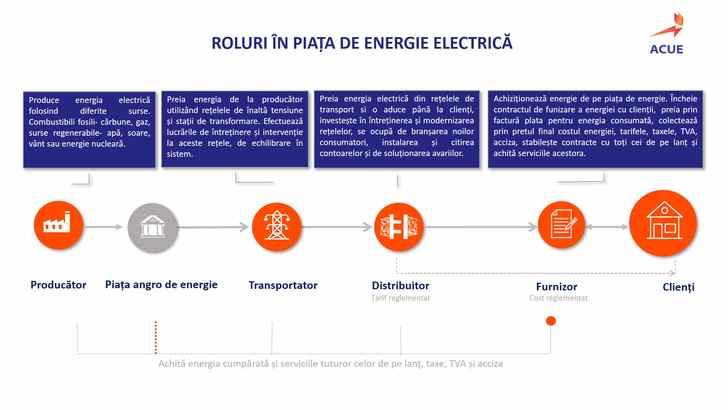Although only a flick of a switch away, electricity has a long way to go before it reaches our homes. In order to benefit from the energy without which we can no longer imagine our daily life, two big processes take place in parallel. One, let’s call it the technical, is the one that brings the energy into our homes and the second, the commercial, is the one that makes it possible to pay for the energy consumed.
On the strictly technical flow, the producer, the transporter and the distributor of energy are involved. On the commercial flow, the trading of energy takes place in the specific market, its commercialization and billing, a process covered by the supplier.
The electricity producer uses as primary sources for energy production – fossil fuels – gas, coal, or uranium for nuclear energy, resources physically limited by existing deposits, or the energy of water, sun, wind, and renewable resources. Energy systems use all these forms of energy production, in different proportions, depending on the specifics of the resources available to each individual country.

The intention at the European level, as included in the well-known Green Deal, is for the share of plants that produce energy from renewable sources to increase in the energy mix, so as to reduce the impact on the environment, in the long term. Hence the concerns for investment in new generation plants or in the expansion of networks, which would include new producers, including consumers who choose to produce their own energy from renewable sources (so-called prosumers).
Back to the production chain, the energy made available by the producer is taken over by the transporter through high voltage networks and transformer stations. Then it is the distributor that takes the energy through other types of networks and takes it to the customers’ electrical panels and their meters. The distributors are those who make sure that the networks work, they invest in their development, intervene in case of breakdowns and check the level of consumption by reading the meters.
Find details on how to read the meter depending on the type you have installed on the dedicated website www.autocitiri.ro!
The supplier has the role to harmonize, from a commercial point of view, the relationship between producers, transporters, distributors and end-consumers of energy. The suppliers buy from the energy market the quantities needed to supply the customers, contract this energy with the producer or other suppliers, secure the contracts with the transporter, the distributor and respectively with the end-customer, the one who pays for the service of using the energy.
Passing this route involves costs for each segment that are to be found in the bill issued by the energy supplier. The energy production component aggregates the highest cost, representing 50% of the electricity bill. The transport and distribution tariffs are added, distinct, as regulated by law and established by ANRE orders. As for supply costs, they are capped from April 1, 2022, at 0.073 lei/kWh for electricity. Thus, from the total value of the invoice paid to the supplier, only a small part remains with it, namely the supply service, and the rest of the money is paid to the producers, the transport operator, the distribution operator and to the state budget (VAT, green certificates, the contribution for cogeneration, excise duty).
Getting to the environmental impact reduction, decarbonization and waste reduction objectives concern not only producers but also consumers. The way each of us consumes energy impacts the entire chain. Monitoring energy consumption thus becomes important both for each individual and for the entire ecosystem. Self-reading the index and transmitting it to the supplier is a simple and handy step to keep energy costs under control, adjust consumption and increase energy efficiency. On the dedicated website www.autocitiri.ro, you can find details on how to read the meter depending on the type of the equipment you have installed.
